| Kiyohiko Ushihara's
Shingun
(Marching
On)
"Banzai" for a High-Flying Silent Classic By William M. Drew
Kiyohiko Ushihara's 1930 silent film, Shingun or Marching On, released in the 1990s on VHS tape by the original producing company, Shochiku, is a rare example of a truly large-scale production from Japan's silent cinema and remains a powerful, engrossing film. A war spectacle directly influenced by The Big Parade and Wings, it is a modern heroic epic with reverberations in 20th century Japanese history, a well-constructed narrative expertly blending humor, romance, adventure, and social commentary. Director Kiyohiko Ushihara (1897-1987) was one of the leading Japanese filmmakers of the prewar era. Born in Kyushu, he attended the University of Tokyo and was the first Japanese film director to graduate from a university. In 1920, he became a pupil of the Russian emigre actress, Anna Slavina, at the acting school established by the newly formed Shochiku film company. He gained valuable experience at Shochiku by writing the script for Minoru Murata's Souls on the Road (1921), generally considered to be the first great Japanese film, and was soon promoted by the studio to be a director in his own right. In one of his 1923 films, he directed a film starring Anna Slavina's daughter, Ekaterina Slavina, the first European actress to play leads in Japanese films. Also in 1923, he directed the first part of a two-part production of Victor Hugo's Les Misérables, the first of five Japanese versions of Hugo's literary masterpiece. Entitled Aa Mujo (Ah, No Mercy), the title by which Hugo's novel is widely known in Japan, the 1923 film starred Masao Inoue (later the star of Teinosuke Kinugasa's A Page of Madness) as Jean Valjean and was scripted by the future major director, Daisuke Ito. It was given an ancient Chinese setting due to the contemporary Japanese popularity of American films with Chinese characters and settings, such as Griffith's Broken Blossoms. According to Ushihara's recollections nearly 60 years later, the scenes at the Bishop's house were filmed at the Mampukuji Temple at Uji, the headquarters of the Obaku sect of Zen Buddhism built in the Chinese style, while the prison scenes were shot in a building at the compound of Yokohama's Chinese cemetery with Ushihara himself playing a jailer. Although he had successfully established himself as a director in Japan, Ushihara decided to familiarize himself firsthand with the American cinema and in the mid-twenties studied for a year under no less than Charlie Chaplin. Returning to Japan in 1927, he directed such popular romantic comedy-dramas for Shochiku as Love of Life (1927), He and Life (1928), and The Life of Workers in the Big City (1928), pictures which increased his standing with the public and earned him the nickname, "Sentimental Ushihara." By 1930, the year Shingun and another major Ushihara film, Why Do You Cry, Young People?, were released, he was at 33 Shochiku's senior director and the logical choice for the studio's costliest, most ambitious production of the year. From 1928 to 1932, he also co-edited with Minoru Murata Eiga Kagaku Kenkyu (Scientific Study of Cinema), a pioneering Japanese journal which published technical information and critical analyes of film art. After leaving Shochiku, Ushihara continued to work at other studios, remaining a leading director of Japanese cinema until 1949. One of his most notable talkies is The Cat and the Mysterious Shamisen (1938), an exploration into the supernatural with surreal touches starring Sumiko Suzuki. In his later years, he taught film at Nippon University and served on the juries of international film festivals.
From his players, Ushihara draws sensitive performances, completely naturalistic without a display of theatrics. The film has sentiment but never descends to bathos. The scene in which Koichi's parents have an emotional reunion with their son on the eve of his departure for the conflict memorably conveys the sorrowful mood of parting in wartime. At the same time, Ushihara's frequent display of humor leavens the tone, such as when the hero's sidekick returns airsick from his first time up in a plane.
The action then returns to the exploits of the hero and his comrades. There are long-shots of aerial combat as in the American World War I aviation epics. When the hero's buddy is wounded, Koichi helps him bail out of the plane. Under fire, the two make a daring escape on first a motorcycle, then a horse, and finally a military tractor. During intense firing that night, Koichi is caught up in trench warfare when he makes his way with his two wounded comrades to the military hospital. One of them, an officer, dies after asking for a cigarette, his death symbolized by a close-up of the gently swaying, flickering hospital lamp. Following is a masked, CinemaScope-like image of Japanese forces under fire from a machine-gun in the right foreground of the frame, then shots of the victorious Japanese soldiers celebrating. The final shots are of a train speeding by the seacoast. Close views of the passengers in the windows reveal, among others, the hero's parents, the heroine's father, and the hero and heroine traveling together on the same car, emblematic of the class-leveling in this new era. For the battle scenes, Ushihara secured the cooperation of the Japanese army. The result is a two-hour film produced on a far more massive scale than most Japanese silents which, for all their artistry and technical sophistication, were usually more economically made than many American and European films of the same era. Although Shingun is patriotic in sentiment and the protagonist fulfills his destiny through a display of heroics on the battlefield, there is little sense of obvious propaganda in the film. There is no attempt to justify the events on political grounds through melodramatic imagery. For example, there is no demonization of the enemy in the film. Indeed, there is no reference to any specific event or cause of the war other than Koichi's father mentioning that the patience of the Japanese is wearing thin. It is possible that the military campaign shown in the film is the 1928 Japanese intervention in Shandong against the Chinese Guomindang, but, with no indication in the intertitles, it could just as easily be a fictional conflict devised for the narrative. Ushihara's vision remains humanistic, powerfully conveying the horrors of war as in a scene when the hero comes across the bodies of two of his comrades on the battlefield. Contemporary military or war films were rare in the Japanese silent cinema, but Shingun anticipated many of the Japanese war films of a decade later, works which Donald Richie noted tended to avoid propaganda. He writes in his 1971 book, Japanese Cinema: These films were composed of the little things of which soldiers' lives are made ... These films were essentially humanistic in outlook; they were made by those who opposed most of what the military stood for ... It was not necessary to hide horror nor to present a rationale for war. It was necessary only to show the people what was required of them.
Like The Big Parade and Wings, Shingun contrasts peace and war through the blending of the pastoral and the epic. But the protagonists of the Vidor and Wellman epics, caught up in a patriotic fervor, enlist in the service of their country. They are eager to attain martial glory and their fates become symbolic for the devastation of an entire generation of youth. In The Big Parade, Jim Apperson loses a leg and both his comrades die on the battlefield; while in Wings, Jack Powell (Charles "Buddy" Rogers) shoots down his best friend in the mistaken belief that he is the enemy. The undercurrent in both films, therefore, represents disillusionment with war. Shingun, however, strikes a different chord. While not glorifying war, and accurately showing its horrors, its approach is rooted in the hero's motivations. He enlists at a time of peace with a yearning to elevate his status in society. From the beginning of the film, it is obvious that he is caught up in the excitement, not of war, but of learning to fly. Indeed, his dreams, as he devotedly builds model airplanes, are those of young people worldwide who had been transfixed by Lindbergh's epochal flight in the twenties. The war is but a circumstance that develops in the course of his service.
Copyright © 1996, 2003 by William
M. Drew
An earlier version of this article was first published on The Silents Majority website. This revision is possible thanks to the assistance of Mitsuyoshi Yamada who translated the intertitles and Hiroshi Komatsu, archivist and professor of film history at Waseda University, who provided background information. |
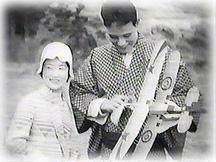 The stars of Shingun, Denmei Suzuki (1900-1985) and Kinuyo Tanaka
(1910-1977), were a popular on-screen couple, the Japanese counterparts
of Charles Farrell and Janet Gaynor. They had previously worked under
Ushihara's direction in He and Life and The Life of Workers in
the Big City. Both would become outstanding directors in their
own right. Before beginning his film career, Suzuki had been a champion
athlete as a medal-winning member of Meiji University's swimming team.
His co-starring role in Souls on the Road made him a leading Japanese
star for over a decade. In 1936, he directed one of the Japanese cinema's
first musicals, the exuberant, jazzy Whispering Shadows, starring
the Japanese-American performer, Betty Inada. After World War II,
he made an attempt to enter politics. Kinuyo Tanaka, for her part, had
a career in Japanese cinema that lasted for over half a century as she
effortlessly moved from silents to talkies and graduated from romantic
leads to character roles. Working with such great directors as Yasujiro
Ozu and Kenji Mizoguchi, she gained the experience to become Japan's first
woman film director in the 1950s. She was still a leading star and one
of the world's most acclaimed actresses when she died in 1977 at the age
of 66.
The stars of Shingun, Denmei Suzuki (1900-1985) and Kinuyo Tanaka
(1910-1977), were a popular on-screen couple, the Japanese counterparts
of Charles Farrell and Janet Gaynor. They had previously worked under
Ushihara's direction in He and Life and The Life of Workers in
the Big City. Both would become outstanding directors in their
own right. Before beginning his film career, Suzuki had been a champion
athlete as a medal-winning member of Meiji University's swimming team.
His co-starring role in Souls on the Road made him a leading Japanese
star for over a decade. In 1936, he directed one of the Japanese cinema's
first musicals, the exuberant, jazzy Whispering Shadows, starring
the Japanese-American performer, Betty Inada. After World War II,
he made an attempt to enter politics. Kinuyo Tanaka, for her part, had
a career in Japanese cinema that lasted for over half a century as she
effortlessly moved from silents to talkies and graduated from romantic
leads to character roles. Working with such great directors as Yasujiro
Ozu and Kenji Mizoguchi, she gained the experience to become Japan's first
woman film director in the 1950s. She was still a leading star and one
of the world's most acclaimed actresses when she died in 1977 at the age
of 66.
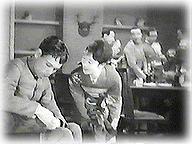 The story and screenplay of Shingun were written by Kogo Noda (1893-1968),
Yasujiro Ozu's close friend and scenarist of the majority of his films.
The narrative deals with a young man named Koichi (Denmei Suzuki), a farmer's
son who dreams of aviation. He falls in love with Toshiko Yamamoto (Kinuyo
Tanaka), a neighboring wealthy landowner's daughter who has just returned
from attending college in Tokyo. When he attends a party at
her home with officers from a nearby regiment, he feels unworthy of her
because of his peasant background. He resolves to take action and enlists
in the aviation school attached to the army. He serves as a flyer during
a Japanese military campaign, performing heroic deeds in the air and on
the battlefield as he rescues his comrades. Having triumphed over class
barriers, he is now free to marry the girl of his dreams.
The story and screenplay of Shingun were written by Kogo Noda (1893-1968),
Yasujiro Ozu's close friend and scenarist of the majority of his films.
The narrative deals with a young man named Koichi (Denmei Suzuki), a farmer's
son who dreams of aviation. He falls in love with Toshiko Yamamoto (Kinuyo
Tanaka), a neighboring wealthy landowner's daughter who has just returned
from attending college in Tokyo. When he attends a party at
her home with officers from a nearby regiment, he feels unworthy of her
because of his peasant background. He resolves to take action and enlists
in the aviation school attached to the army. He serves as a flyer during
a Japanese military campaign, performing heroic deeds in the air and on
the battlefield as he rescues his comrades. Having triumphed over class
barriers, he is now free to marry the girl of his dreams.
 The director further enriches his narrative with artistic visual effects
and precise social delineations. One sees the life of a Japanese peasant-farmer
in the twenties--the age-old methods of plowing decades before the introduction
of mechanization, and the manner of dress in that period. The humble quarters
of the hero and his parents, the setting for the moving domestic scenes,
are a striking contrast to the spacious, Western-style house of the heroine
and her father. In one scene symbolizing Koichi's growing affection for
Toshiko, her lovely face appears superimposed over shots of him building
a model airplane in his bedroom. In another scene, the camera rapidly and
wildly traverses the flying scenery, giving the viewer a vivid sense of
headlong motion, as the hero comes to Toshiko's rescue when her horse runs
away with her. In still another memorable sequence, Koichi, returning to
his native village on leave, stands outside the window of his sweetheart
whom he thinks he has lost because of his social status. Toshiko, unaware
that he is there, sadly looks out at the rainy night. Throughout
the film, Ushihara adopts an unusual approach to editing by frequently
dissolving one image into another within the scenes.
The director further enriches his narrative with artistic visual effects
and precise social delineations. One sees the life of a Japanese peasant-farmer
in the twenties--the age-old methods of plowing decades before the introduction
of mechanization, and the manner of dress in that period. The humble quarters
of the hero and his parents, the setting for the moving domestic scenes,
are a striking contrast to the spacious, Western-style house of the heroine
and her father. In one scene symbolizing Koichi's growing affection for
Toshiko, her lovely face appears superimposed over shots of him building
a model airplane in his bedroom. In another scene, the camera rapidly and
wildly traverses the flying scenery, giving the viewer a vivid sense of
headlong motion, as the hero comes to Toshiko's rescue when her horse runs
away with her. In still another memorable sequence, Koichi, returning to
his native village on leave, stands outside the window of his sweetheart
whom he thinks he has lost because of his social status. Toshiko, unaware
that he is there, sadly looks out at the rainy night. Throughout
the film, Ushihara adopts an unusual approach to editing by frequently
dissolving one image into another within the scenes.
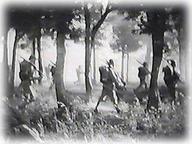 From the pastoral lyricism of the film's early scenes with the shots of
the Japanese countryside, Shingun shifts to the violent energy and
epic spectacle of the war scenes. The war itself is first introduced suddenly
midway in the film with a close-up of ringing bells succeeded by shots
of soldiers on the march, newspaper headlines, a battleship, and a patriotic
crowd that includes the hero's parents waving the flag of the Rising Sun.
But it is the final third of the film that is given over almost entirely
to the depiction of war. Ushihara begins by showing lines of tanks, trucks,
cavalry, and marching soldiers moving to the front followed by shots of
soldiers advancing under fire through the woods to a field, clearly emulating
scenes in The Big Parade. But where Vidor's pacing in these sequences
is keyed to a slow, death-like march, Ushihara's tempo is fast-paced. His
"big parade" moves with increasingly lightning-like speed to the front,
and his camera pans rapidly across a close-up of the opposing force's machine
gun firing on the advancing Japanese. To punctuate the violence, there
are shots of the grain on the battlefield wildly tossing under the impact
of the artillery.
From the pastoral lyricism of the film's early scenes with the shots of
the Japanese countryside, Shingun shifts to the violent energy and
epic spectacle of the war scenes. The war itself is first introduced suddenly
midway in the film with a close-up of ringing bells succeeded by shots
of soldiers on the march, newspaper headlines, a battleship, and a patriotic
crowd that includes the hero's parents waving the flag of the Rising Sun.
But it is the final third of the film that is given over almost entirely
to the depiction of war. Ushihara begins by showing lines of tanks, trucks,
cavalry, and marching soldiers moving to the front followed by shots of
soldiers advancing under fire through the woods to a field, clearly emulating
scenes in The Big Parade. But where Vidor's pacing in these sequences
is keyed to a slow, death-like march, Ushihara's tempo is fast-paced. His
"big parade" moves with increasingly lightning-like speed to the front,
and his camera pans rapidly across a close-up of the opposing force's machine
gun firing on the advancing Japanese. To punctuate the violence, there
are shots of the grain on the battlefield wildly tossing under the impact
of the artillery.
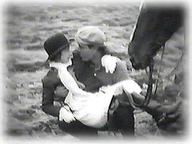 Shingun also stands out in its depiction of social structures, reflected
in the contrast between the old Japan and the new. Like Howard Hawks in
Sergeant
York a decade later, Ushihara devotes considerable time to the portrayal
of rural life and the hero's status as a peasant-farmer. He is first seen
daydreaming in his field when an airplane suddenly lands nearby. The pilot
hands him his card before taking off. So enthralled is Koichi by this tantalizing
glimpse of the modern world that he runs behind the plane hanging on to
it until it leaves the ground. In another example of the juxtaposition
between old and new, rich and poor, he first meets Toshiko when he intervenes
to stop a fight between his father and the chauffeur of the limousine in
which she is riding, an altercation that had arisen because the farmer's
wagon was blocking the car which ran over one of the chickens. This comic
sequence which brings the hero and heroine together foreshadows the film's
ultimate denouement resolving the differences in their backgrounds. The
relation between the protagonists in Shingun
is the inverse of the
hero's position in The Big Parade. There, Jim Apperson (John
Gilbert) is a wealthy youth who is placed on an equal footing with his
proletarian comrades in the trenches while falling in love with a French
peasant girl. In Shingun, it is Koichi's service in the new mass
army of Japan that enables him to overcome Old World class stratification.
Shingun also stands out in its depiction of social structures, reflected
in the contrast between the old Japan and the new. Like Howard Hawks in
Sergeant
York a decade later, Ushihara devotes considerable time to the portrayal
of rural life and the hero's status as a peasant-farmer. He is first seen
daydreaming in his field when an airplane suddenly lands nearby. The pilot
hands him his card before taking off. So enthralled is Koichi by this tantalizing
glimpse of the modern world that he runs behind the plane hanging on to
it until it leaves the ground. In another example of the juxtaposition
between old and new, rich and poor, he first meets Toshiko when he intervenes
to stop a fight between his father and the chauffeur of the limousine in
which she is riding, an altercation that had arisen because the farmer's
wagon was blocking the car which ran over one of the chickens. This comic
sequence which brings the hero and heroine together foreshadows the film's
ultimate denouement resolving the differences in their backgrounds. The
relation between the protagonists in Shingun
is the inverse of the
hero's position in The Big Parade. There, Jim Apperson (John
Gilbert) is a wealthy youth who is placed on an equal footing with his
proletarian comrades in the trenches while falling in love with a French
peasant girl. In Shingun, it is Koichi's service in the new mass
army of Japan that enables him to overcome Old World class stratification.
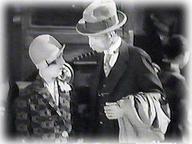 Shingun was released the year before the Japanese invasion of Manchuria
in 1931 put the country on a tragic course that would lead to the unimaginable
horrors of Japan's aggression against China in 1937. But while this
was to be the historical effect of Japanese imperialism, with Japan's government
still headed by moderates in 1930, it appeared to liberals of Ushihara's
generation that civilians were continuing to maintain control over the
military. In this climate, Ushihara was able to place his film above
the ideological battlefield to create a vision emblematic of a nation's
striving for freedom. As the hero seeks the physical liberty of flight
and the social liberty of a release from feudal and class structures through
an assertion of acts of individual courage, his heroism is ultimately manifested
in the saving of his comrade's lives rather than the taking of the enemy's.
Like other Japanese films of the era, Shingun confronts the legacy
of feudal rank as it lingered in Japan's modern society and seems to conclude
that the true worth of a person rests on his qualities as an individual
rather than his social status.
Shingun was released the year before the Japanese invasion of Manchuria
in 1931 put the country on a tragic course that would lead to the unimaginable
horrors of Japan's aggression against China in 1937. But while this
was to be the historical effect of Japanese imperialism, with Japan's government
still headed by moderates in 1930, it appeared to liberals of Ushihara's
generation that civilians were continuing to maintain control over the
military. In this climate, Ushihara was able to place his film above
the ideological battlefield to create a vision emblematic of a nation's
striving for freedom. As the hero seeks the physical liberty of flight
and the social liberty of a release from feudal and class structures through
an assertion of acts of individual courage, his heroism is ultimately manifested
in the saving of his comrade's lives rather than the taking of the enemy's.
Like other Japanese films of the era, Shingun confronts the legacy
of feudal rank as it lingered in Japan's modern society and seems to conclude
that the true worth of a person rests on his qualities as an individual
rather than his social status.